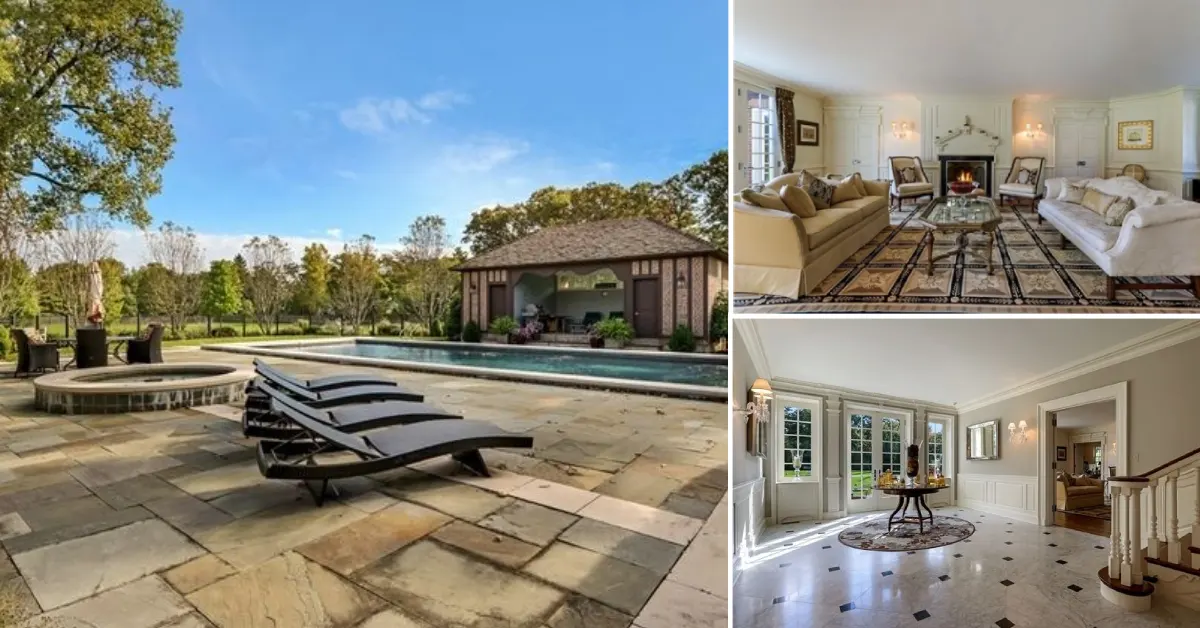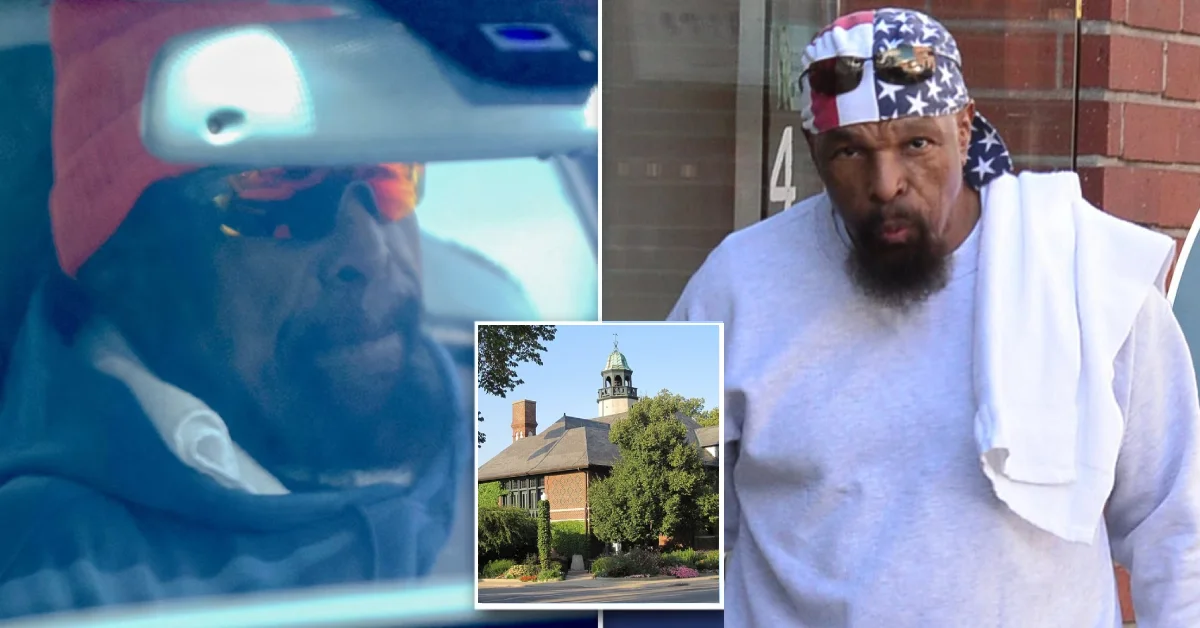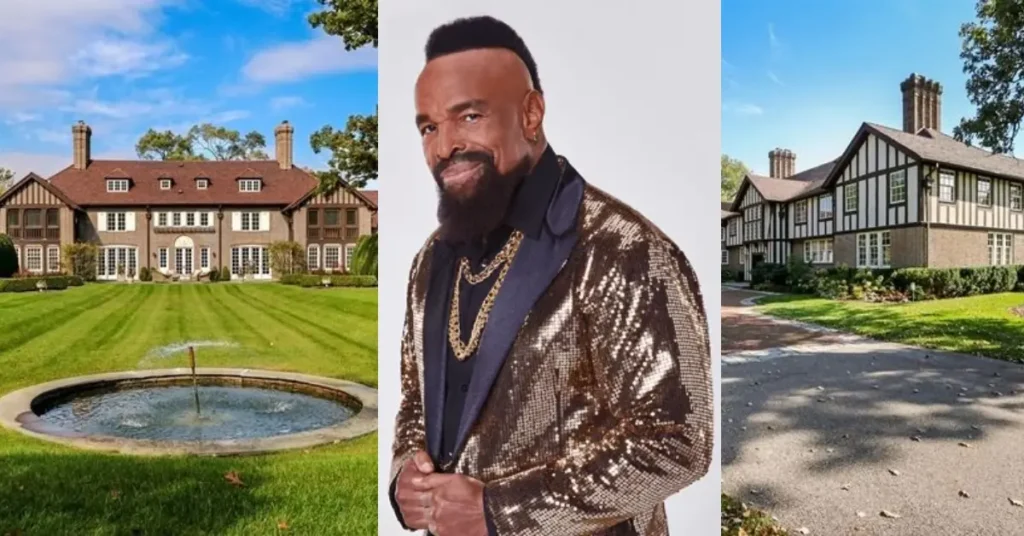When a famous TV tough guy took a chainsaw to over 100 trees on his luxury estate, he sparked what locals still call “The Lake Forest Chainsaw Massacre.” This is how Mr. T’s historic Tudor mansion went from a wooded sanctuary to a controversial celebrity home—and eventually became a $5 million restored masterpiece.
The Estate Known as “Two Gables”
Nestled in the exclusive Lake Forest community along Chicago’s North Shore, the property, now forever linked with 1980s icon Mr. T, began its life as something far more elegant than a pop culture footnote. Built in 1910, the grand Tudor Revival mansion was originally named “Two Gables” for its distinctive roofline.
The 7.5-acre estate sits on a sprawling lot that once showcased magnificent old-growth trees and carefully placed gardens. With roughly 15,000 square feet of living space, the mansion commands attention without being ostentatious—at least until its most famous owner arrived.
Long before becoming known as “Mr. T House,” this historic residence represented the pinnacle of North Shore prosperity. The estate’s transition from architectural treasure to celebrity scandal site makes it one of the most storied properties in Chicago’s wealthy suburbs.
The Man Behind the Chainsaw: Mr. T’s Arrival
In 1986, at the height of his fame from “The A-Team” television series, Laurence Tureaud—better known as Mr. T—purchased the Lake Forest estate for $1.7 million. The tough-talking actor with his signature mohawk and gold chains seemed an unlikely fit for the buttoned-up North Shore community.
Mr. T brought his larger-than-life persona to the quiet streets of Lake Forest. For neighbors accustomed to old money discretion, the celebrity’s arrival represented a culture clash that would soon spiral into headline-making controversy.
The purchase came during a career high point for the Chicago native, who had risen from poverty to become a household name through wrestling, acting, and his distinctive personal brand. The mansion symbolized his success—a far cry from his humble beginnings.
Architectural Heritage and Design

Before becoming associated with celebrity drama, the mansion boasted impressive architectural credentials. The original 1910 Lindeberg design showcased Tudor Revival elegance with distinctive gables, leaded glass windows, and substantial masonry work.
Over the decades, the property benefited from contributions by notable figures in design and landscaping. David Adler, one of America’s most distinguished residential architects, completed renovations that enhanced the property’s historical significance. Meanwhile, renowned landscape architect Jens Jensen created the original flowing, naturalistic grounds that complemented the estate’s wooded setting.
The mansion features nine bedrooms, ten bathrooms, multiple fireplaces, and even a functional elevator—rare for homes of its era. A separate coach house provides additional living space and historic charm. These elements created not just a house but a landmark of architectural importance.
The Infamous Tree Massacre
What happened in 1987 would forever change both the property and Lake Forest’s approach to tree preservation. In what quickly became a local legend, Mr. T ordered the removal of more than 100 mature trees from his property—many of them over 100 years old.
The actor cited severe allergies as his motivation. While tree pollen can trigger significant allergic responses, the scale of the removal shocked neighbors and preservationists alike. In a single day, the leafy character of the historic estate vanished under the roar of chainsaws.
Local news cameras captured the aftermath—stark, barren grounds surrounding the Tudor mansion. One longtime resident described it as “looking like a war zone.” The Chicago Tribune dubbed the incident “The Lake Forest Chainsaw Massacre,” a name that stuck in local lore.
Why Did He Cut Down the Trees?
Mr. T later explained that his decision stemmed from serious health concerns. “Those trees was hurting me. My eyes was watering, my nose was running, I was sneezing,” he told reporters. Medical records confirmed the actor suffered from severe allergies, but many questioned whether removing every tree was necessary.
Some speculated the dramatic landscape change reflected Mr. T’s desire to make his mark on the property—eliminating its established character and creating something unmistakably his. Others suggested it demonstrated his outsider status, misreading local values around preservation and discretion.
The removal sparked immediate outrage. Neighbors protested the visual impact and potential erosion issues. Preservationists mourned the loss of specimen trees that had defined the property for generations. Local officials scrambled to respond to what they considered an assault on community character.
Interior and Exterior Transformations
The tree removal wasn’t Mr. T’s only controversial change. Inside, the actor undertook dramatic renovations that further distanced the mansion from its elegant past. Red shag carpeting replaced traditional hardwood floors in many rooms. Bold black and red fixtures transformed bathrooms and the kitchen into statements of 1980s celebrity style.
Outside, beyond the tree removal, Mr. T installed a tall stockade fence around the perimeter—a security measure that neighbors viewed as another violation of community aesthetics. The fence required special permission from town officials, further straining relations with neighbors.
These interior changes represented significant departures from the home’s architectural heritage. Original moldings, fixtures, and finishes were altered or removed to accommodate Mr. T’s personal style preferences.
Property Specifications and Features
Despite controversial changes during Mr. T’s ownership, the mansion’s bones remained impressive. The estate encompasses approximately 15,000 square feet of living space on 7.5 acres of land. Its nine bedrooms and ten bathrooms provide ample space for family and guests.
Multiple fireplaces throughout the home offer both warmth and architectural focal points. The restored vintage elevator represents a rare amenity and connection to the home’s historic past. The separate coach house provides additional living quarters or staff housing.
The mansion’s Tudor Revival style features exposed timbers, decorative brickwork, and substantial stone elements. Leaded glass windows allow natural light to come in while maintaining period authenticity. Though Mr. T’s renovations altered many interior spaces, subsequent owners have worked to restore architectural integrity.
Ownership Timeline and Value Evolution
After Mr. T’s controversial tenure, the property began a journey through multiple owners and price points:
1986: Mr. T purchased the property for $1.7 million 2003: Mr. T sold to developers for $3.85 million 2009: The Cummins family acquired the estate for $4.625 million 2017: Listed again with asking prices between $7.5-7.9 million 2021: Sold for $5 million after significant price adjustments
This timeline reflects not just ownership changes but evolving property values in Lake Forest’s luxury market. The substantial jump from Mr. T’s purchase price to subsequent sales demonstrates both market appreciation and specific improvements made by later owners.
The final 2021 sale price of $5 million fell substantially below the optimistic 2017 asking price, suggesting either market corrections or lingering concerns about the property’s complicated history.

Restoration and Renewal
Following Mr. T’s departure in 2003, subsequent owners embarked on significant restoration efforts. The Cummins family, who purchased the property in 2009, took a particular interest in healing both the land and the house itself.
Outside, an ambitious reforestation project replaced the lost tree canopy. Approximately 150 new trees were planted throughout the grounds, though experts note it will take generations before they match the maturity of those removed during Mr. T’s ownership.
Inside, extensive renovations removed the more dated elements from the actor’s tenure. Out went the red shag carpeting and black fixtures. In came materials and finishes more appropriate to the home’s architectural pedigree. A substantial 5,000-square-foot wing was added, bringing modern amenities while respecting the original design.
The vintage elevator underwent careful restoration to working condition. These combined efforts helped restore the estate’s heritage appeal while adapting it for contemporary luxury living.
Community Impact and Legacy
Perhaps the most lasting impact of Mr. T’s brief ownership wasn’t on the property itself but on Lake Forest policy. In direct response to the “Tree Massacre,” the town quickly enacted one of the region’s strictest tree preservation ordinances.
The new regulations required permits for removing any tree over a certain diameter, established replacement requirements, and created substantial penalties for violations. Local officials credit this ordinance with preserving thousands of trees across Lake Forest in the decades since.
“Mr. T inadvertently became a conservationist,” noted one local historian. “His actions shocked the community into protecting something they had previously taken for granted”
The incident lives on in local memory. Longtime residents still reference “The Lake Forest Chainsaw Massacre” when discussing preservation issues. The property itself became a cautionary tale about celebrity ownership in established communities.
Celebrity Connections and Media Coverage
Mr. T’s ownership wasn’t the only brush with celebrity for the Lake Forest mansion. In 2006, rumors swirled that Jennifer Aniston had toured the property during a house-hunting expedition. While the “Friends” star ultimately didn’t purchase it, the story kept the estate in entertainment news circles.
National media took notice of both the tree removal controversy and the property’s subsequent sales. The New York Times covered the mansion’s market journey. Local news outlets regularly featured updates on restoration efforts and ownership changes.
Online real estate trackers and celebrity home websites ensure the property remains in public consciousness decades after Mr. T’s departure. For better or worse, the “Mr. T House” label has stuck, overshadowing its historical “Two Gables” name in popular references.
Current Status and Market Position
Today, the restored mansion stands as both an architectural landmark and an unusual footnote in celebrity real estate history. The 2021 sale at $5 million represents significant value compared to other Lake Forest luxury properties but also acknowledges the estate’s complicated past.
The property now features a blend of historical elements and modern amenities. The grounds once again showcase maturing landscaping, though forestry experts estimate it will take another 50-75 years before the replacement trees fully mature.
Current owners maintain a lower profile than the property’s famous former resident, focusing on preserving the estate’s architectural integrity rather than making headlines. Real estate analysts note that the property has finally shed many of the market challenges associated with its controversial history.
For architectural enthusiasts and local historians, the mansion represents resilience—how even a property subjected to dramatic alterations can eventually return to something approaching its original dignity. For Lake Forest residents, it serves as a reminder of how quickly community character can change without proper protections.
The story of “Mr. T House” encapsulates themes of celebrity, conservation, architectural preservation, and community values. What began as a simple luxury home purchase became a transformative moment for an entire town—proving that sometimes even the most unlikely property owner can leave a lasting legacy, though perhaps not the one they intended.


